Centauri Dreams
Imagining and Planning Interstellar Exploration
Calibrating Distances to Low Mass Stars
Accurate distances are critical for understanding the physical properties of brown dwarfs and low-mass stars. We need to know the intrinsic brightness of these objects to proceed, but we can’t know that until we have an idea of their distance. After all, a relatively faint star can seem much brighter if nearer to us, while a distant bright star can appear deceptively dim. Intrinsic brightness is a measure of how stars would appear if observed at a common distance.
Enter an exoplanet search that began at the Carnegie Institution for Science in 2007, using the Carnegie Astrometric Planet Search Camera (CAPSCam) to look for gas giant planets and brown dwarfs orbiting nearby low-mass stars. A new report from the program tells us that it has measured the distance to 134 low-mass stars and brown dwarfs, 38 of which have had no previously measured trigonometric parallax.
These are all stars considered too faint for inclusion in the European Space Agency’s Hipparcos survey, but as the report explains, they are considered “…the best templates for studies of radii, atmospheric composition, metallicity, and other spectroscopic properties. In addition, low mass stars with excellent distances provide the templates for spectrophotometric distances to more distant stars.”
The Carnegie survey has focused on M, L and T dwarfs in the southern sky (CAPSCam operates on the 2.5-m du Pont instrument at the Las Campanas Observatory
in Chile). All the objects surveyed were believed to be within 20 parsecs (about 65 light years). The CAPSCam work is primarily about searching for exoplanets using astrometry, which attempts to detect the wobble of a host star around the center of mass of the system. The wobble is a telling indicator that a planetary object is affecting the host star’s motion.
Usefully for distance studies, CAPSCam is also capable of collecting parallax information. Here a target’s position in the sky is measured against a far more distant background from different points in the Earth’s orbit, allowing us to calculate the distance of the closer object. Stellar parallax was the method first used by Friedrich Bessel in measuring the distance to the star 61 Cygni at Königsberg Observatory. Accurate parallax computations from Earth’s surface are limited to about 300 light years because the more distance a star is, the smaller its parallax.
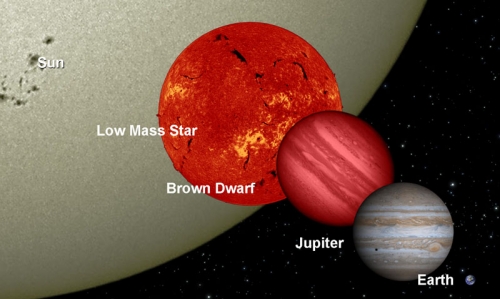
Image: A brown dwarf in relation to Earth, Jupiter, a low-mass star and the Sun. Credit: NASA.
Among the more interesting finds is GJ 3470, an M-dwarf with no previously published parallax. The Carnegie team comes up with a distance of roughly 29 parsecs, or 95 light years. GJ 3470 is significant because it is one of the few low-mass stars known to host a large planet, in this case a Neptune analog. The distance measurement allowed the researchers to refine earlier radius and density estimates, finding the planet is about half as dense as Neptune.
Also interesting is 2MASS J01392170?3936088, previously computed at about 15 parsecs, but now found to be slightly less than 9 parsecs (29 light years). Another brown dwarf, 2MASS J01365662+0933473, had no previously computed parallax. The new work finds it at a distance of 6.4 parsecs (20 light years). A number of earlier parallax distance computations are revisited in the paper, in some cases as much as doubling the previously calculated number.
In general, the CAPSCom work meshes with earlier parallax studies, with a few exceptions. From the paper:
For 79 of the 96 stars with previously published parallaxes, our measurements have lower uncertainty. In general there is very good agreement between ours and previous measurements; only 12 of the 96 disagree by more than 3 ? (of the less accurate measurement), and for 8 of these 12, the difference in parallax is <5%.
And as mentioned earlier, 38 of the CAPSCam targets had no previously measured parallax. Measurements like these can also help us learn a given star’s age, as witness G 161-71, whose parallax combined with the star’s radial velocity allows the team to peg it as part of the 30-50 million year old Argus association, a so-called ‘moving group’ of stars of similar age. The M-dwarf LP 870-65 is similarly found to be part of another moving group, the AB Doradus association, allowing the researchers to peg its age as approximately 100 million years.
Any fine-tuning of distance measurements is useful in determining stellar properties, but we’re especially interested in brown dwarfs because of the clues they may offer about star formation. After all, they can be found in mass ranges between gas giant planet and small star. M-dwarfs, meanwhile, are already known to host numerous planets, whose transit signatures will be studied by upcoming missions like TESS (Transiting Exoplanet Survey Satellite) and PLATO (PLAnetary Transits and Oscillations of stars). All this is part of populating our catalog of planets around nearby brown dwarfs, M-dwarfs, K-dwarfs and G-class stars like the Sun.
The paper is Weinberger et al., “Trigonometric Parallaxes and Proper Motions of 134 Southern Late M, L, and T Dwarfs from the Carnegie Astrometric Planet Search Program,” The Astronomical Journal Vol. 152, No. 1 (2016). Abstract / Preprint.

Deep Stare into a Dusty Universe
It’s not often that I get the chance to back up and take a broad look at the universe, the kind of thing that reinforces my interest in cosmology and structure at the grandest scale. But today I’ll take my cue from the Royal Astronomical Society’s annual meeting, now underway in Nottingham UK, which gives me the chance to look at a new catalog from the European Space Agency’s Herschel Space Observatory. On offer is a guide to hidden sources of energy in the universe, on a scale at which the Milky Way itself is but a bit of froth on a cosmic wave.
As presented by Haley Gomez (Cardiff University) at the National Astronomy Meeting, the project known as the Herschel Astrophysical Terahertz Large Area Survey (Herschel-ATLAS) is offering a deep look at galaxies through time. Because about half the light emitted by stars and galaxies is absorbed by interstellar dust grains, Herschel’s ability to work in the far-infrared can reveal that light re-emitted, showing us the sources of energy that would be hidden at visible wavelengths, and at a level of detail that has previously been beyond our reach.
The work highlights half a million far-infrared sources near and far, including galaxies twelve billion light years away, less than two billion years after the Big Bang. The latter are dusty and difficult to observe with conventional telescopes, and as the image below reveals, they are often gravitationally lensed by closer galaxies in the same field of view. Gravitational lensing occurs when an intervening massive object distorts spacetime so that light, following the curved path, is ‘bent’ and magnified. The effect is now exploited in a wide range of astronomical studies.
Image (click to enlarge): An illustration of the time reach of the Herschel ATLAS and the kinds of objects it has discovered. The Big Bang occurred 13.7 billion years ago. The points in the diagram (approximately 40,000) show some of the Herschel ATLAS objects. The survey discovered nearby galaxies fairly similar to our own (see galaxies to the top left), and also galaxies that are so far away that we see them as they were only two billion years after the Big Bang. The figure to the bottom right shows a detailed image made with the Atacama Large Millimetre Array of one of these early galaxies. The spectacular ‘Einstein ring’ shows that the far-infrared emission from this source has been gravitationally lensed by the gravitational field of an intervening galaxy. These ultra-distant galaxies are forming stars at a rate 1000 times greater than in the Milky Way and are shrouded by dust from the view of optical telescopes. These violently star-forming and dusty galaxies are the ancestors of the galaxies around us in the Universe today. Credit: The Herschel ATLAS team, the European Space Agency, ALMA and NRAO.
It’s intriguing to note that some galactic change can still be traced in the relatively recent (in astronomical terms) past. Even one billion years ago, the Herschel ATLAS catalog demonstrates, galaxies were undergoing faster star formation and were more dusty than galaxies today. Nathan Bourne (University of Edinburgh) describes the result:
“We were surprised to find that we didn’t need to look far in the past to see signs of galaxy evolution. Our results show that the reason for this evolution is that galaxies used to contain more dust and gas in the past, and the universe is gradually becoming cleaner as the dust is used up.”
Thus we have a look at cosmic history from the violent star-formation periods in a roiling early universe to a far more sedate cosmos today. Bear in mind that only a few hundred dusty sources from the early universe have been previously studied, whereas the Herschel results offer half a million galaxies as cosmic context, a potential game-changer in our study of early star formation. Says Göran Pilbratt (Herschel Project Scientist): “Although Herschel made its last observation in 2013, current and future generations of astronomers will find the H-ATLAS maps and catalogues essential for finding their way around the hidden universe.”
From the paper (internal references omitted for brevity):
The chief original goal of the survey was to provide a relatively shallow Herschel survey over a very large area of sky, with the specific aims of providing measurements of the dust masses and dust-obscured star formation rate for tens of thousands of nearby galaxies…, complementing the large optical spectroscopic surveys of the nearby Universe, such as the Sloan Digital Sky Survey (SDSS)… and the Galaxy and Mass Assembly project (GAMA). However, the exceptional sensitivity of Herschel, aided by the large and negative k?correction at submillimeter wavelengths…, has meant that a significant fraction of the sources in H-ATLAS actually lie at high redshift…. The H-ATLAS survey is therefore useful both to astronomers studying the nearby Universe and to those studying the early (z > 1) Universe.
And a note of exoplanetary interest that I wouldn’t have expected:
The large area of the survey means that there are also potential uses for it in Galactic astronomy…, with one practical example being a search for debris disks around stars…
Image (click to enlarge): A small glimpse of one region, a tenth of the full area of the Herschel ATLAS images. Everything in this image, apart from the picture of the Moon, which has just been placed there to show the area of sky covered by the survey and the small square that shows the area covered by the Hubble Deep Field, consists of far-infrared emission from cosmic dust. The faint wisps are far-infrared emission from dust grains in the Milky Way but everything else in the image is a dusty galaxy. There are approximately 6000 dusty galaxies detected in this image, while the entire survey contains roughly half a million dusty galaxies, from galaxies similar to our own, to violently star-forming and very dusty galaxies that are being seen as they were over ten billion years ago. This image also shows how the field of hidden astronomy has evolved. The Hubble Deep Field was the first area surveyed by a dust sensitive camera called SCUBA almost 20 years ago. Five galaxies were found and the observations took 50 hrs, meaning it took 10 hours observing time to detect a galaxy. The Herschel-ATLAS maps released today cover an area 100,000 times larger and it took Herschel only 5 seconds on average to detect a galaxy in these images. Credit: The Herschel ATLAS team and the European Space Agency.
Two papers are in press at Monthly Notices of the Royal Astronomical Society. The only one I’ve been able to study so far is Valiante et al., “The Herschel-ATLAS Data Release 1 Paper I: Maps, Catalogues and Number Counts,” not yet available on arXiv, but I’ll get the links to it and a companion paper up as soon as I have them.

Spacecoach: Toward a Deep Space Infrastructure
With manned missions to Mars in our thinking, both in government space agencies and the commercial sector, the challenge of providing adequate life support emerges as a key factor. We’re talking about a mission lasting about two years, as opposed to the relatively swift Apollo missions to the Moon (about two weeks). Discussing the matter in a new essay, Brian McConnell extends that to 800 days — after all, we need a margin in reserve.
Figure 5 kilograms per day per person for water, oxygen and food, assuming a crew of six. What you wind up with is 24,000 kilograms just for consumables. In terms of mass, we’re in the range of the International Space Station because of our need to keep these astronauts alive. McConnell, a software/electrical engineer based in San Francisco, has been working with Alex Tolley on the question of how we could turn most of these consumables into propellant. The idea is to deploy electric engines that use reclaimed water and waste gases to do the job.
With a nod to the transportation technologies that opened the American West, McConnell and Tolley have dubbed the idea a ‘Spacecoach.’ Centauri Dreams readers will remember Tolley’s Spaceward Ho! and McConnell’s A Stagecoach to the Stars, and the duo have also produced a book on the matter for Springer called A Design for a Reusable Water-Based Spacecraft Known as the Spacecoach. The new essay is a welcome addition to the literature on what appears to be a practical concept.
What fascinates me about the Spacecoach is that it enables us to begin building a space infrastructure that can extend past Mars to include the main asteroid belt. Using electric propulsion driven by a solar photovoltaic array, it achieves higher exhaust velocity than chemical rockets by a factor or ten, pulling much greater delta v from the same amount of propellant. Use water as propellant and you reduce the mass of the system by what McConnell estimates to be a factor of between 10 and 20. Huge reductions in cost follow.
Water as propellant? McConnell comments:
Electric propulsion is not a new technology, and has been used on many unmanned spacecraft. The idea is to use an external power source, typically a solar photovoltaic array, to drive an engine that uses an electrical or magnetic field to heat and accelerate a gas stream to great speed (tens of kilometers per second). Because these engines can achieve much higher exhaust velocity than chemical rockets, 10x or better, they can achieve greater change of velocity (delta v) using the same amount of propellant. This means they can venture to more ambitious destinations, carry more payload, or a combination of both. It also turns out these engines can also use a wide range of materials for propellant, including water.
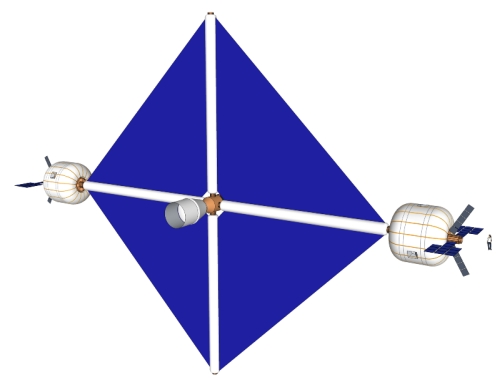
Image: Rendering of the “kite” design pattern for a Spacecoach, with a person shown to the right for scale. This is but one possible configuration, but McConnell notes that the pattern minimizes the materials required even as it provides a sizeable habitable area. Credit: Rudiger Klaen.
We can imagine such ships as interplanetary vessels that never enter an atmosphere. They’re also completely reusable, allowing costs to be amortized, and their habitable areas are large inflatable structures that can be assembled in space. Thus we travel within a modular spacecraft using external landers and whatever other modules are required by the mission at hand. They’re also, compared to today’s chemical rocket payloads, a good deal safer:
The use of water and waste gases as propellant, besides reducing the mass of the system by a factor of ten or more, has enormous safety implications. 90% oxygen by mass, water can be used to generate oxygen via electrolysis, a simple process. By weight, it is comparable to lead as a radiation shielding material, so simply by placing water reservoirs around crew rest areas, the ship can reduce the crew’s radiation exposure several fold over the course of a mission. It is an excellent heat sink and can be used to regulate the temperature of the ship environment. The abundance of water also allows the life support system to be based on a one-pass or open loop design. Open loop systems will be much more reliable and basically maintenance free compared to a closed loop system such as what is used on the ISS. The abundance of water will also make the ships much more comfortable on a long journey.
Having just watched “To the Ends of the Earth,” a superb BBC story about a ship making a passage from Britain to Australia in the age of sail, the word ‘comfortable’ catches my eye. A Spacecoach is a large craft with huge solar arrays and the capability of being spun to generate artificial gravity, thus alleviating another major health hazard. Conditions are more Earth-like, and the abundance of water makes for what would otherwise seem absurd scenarios. Imagine taking a shower on a flight to Mars! The Spacecoach’s water management makes it possible.
McConnell believes that much of the mission architecture can be validated on Earth without the need to build a full-scale spacecraft, with the major emphasis on tuning up the electric propulsion technology that drives the concept. Using water, carbon dioxide and waste gases to test the engines can be the subject of an engineering competition, after which the engines could be tested in small satellites. Ultimately, manned Spacecoaches could be tested in cislunar space before their eventual deployment deeper into the Solar System.
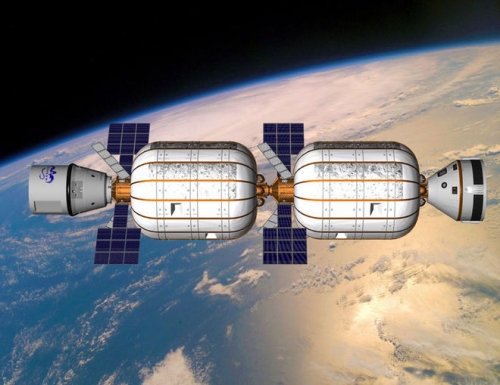
Image: An artist’s concept of two Bigelow BA 330 inflatable modules configured into a space station. Modules like these could provide habitable areas for a Spacecoach. Credit: Bigelow Aerospace (http://www.bigelowaerospace.com).
McConnell calls the Spacecoach the basis of a ‘real world Starfleet,’ and adds this:
These ships will not be destination specific. They will be able to travel to destinations throughout the inner solar system, including cislunar space, Venus, Mars and with a large enough solar photovoltaic sail, to the Asteroid Belt and the dwarf planets Ceres and Vesta. They’ll be more like the Clipper ships of the past than the throwaway rocket + capsule design pattern we’ve all grown up with, and their component technologies can be upgraded with each outbound flight.
So if you haven’t acquainted yourself with McConnell and Tolley’s earlier work on the Spacecoach in these pages, have a look at Traveling to Mars? Just Add Water!, which recaps the basics of the design and outlines surface exploration strategies from orbiting Spacecoaches by telepresence. The key, though, is to mitigate the propellant issue by making consumables into propellant. Get that right and much else will follow, including the prospect of reliable, safe interplanetary transport of the kind needed to build a truly space-going civilization.
And after that? I’ve always believed that after sending instrumented interstellar probes, we’ll expand into regions outside our Solar System slowly, building space habitats as we go, mining local objects for needed materials. A functioning, space-going civilization builds out that infrastructure from within. It’s the ‘slow boat to Centauri’ scenario — our machines, enabled by artificial intelligence, get there first — but it’s a deep future that includes a human presence around other stars. When I see something as evidently practical as the Spacecoach, I get a renewed jolt of confidence that we at least know how to begin such a journey.

A Photon Beam Propulsion Timeline
Breakthrough Starshot’s four-meter sails are the latest (and best funded) concept in a long series of beamed propulsion ideas. As Jim Benford explains below, the idea of beaming to a sail goes back over fifty years, with numerous papers and the beginnings of laboratory work in the intervening decades. What follows is the first cut at a timeline of this work, one that Jim intends to supplement and re-publish here with full references. Keeping in mind the scope of the timeline as Jim explains it, feel free to suggest any missing references in the comments. Discover Magazine, by the way, has just published a look at the Benfords’ work on beamed sails called “Riding on a Beam of Light,” now available for subscribers online.
by James Benford
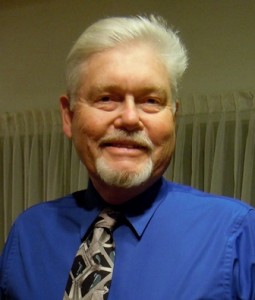
From recent media pieces following the announcement of Breakthrough: Starshot, I gather that the press is not aware of how much has been done by the propulsion community over the last decades in the areas of photon beam-driven sail system concepts, to include experiments and simulations of sail beam-driven flight, sail stability (‘beam-riding’), and dynamics (such as beam-driven spin of sails for stability).
This is a brief history of the deep origins, significant events in the development of beam-driven sails for interstellar travel purposes. It excludes, for example, solar sails, launch to orbit, and mass beams. For those interested in mass beams, my thoughts on the subject, with references, appear in several earlier articles here [see, for example, Sails Driven by Diverging Neutral Particle Beams] as well as in a JBIS review article by Nordley and Crowl (“Mass Beam Propulsion, An Overview”, JBIS 68, pgs. 153-166, 2015).
First mention of beam-driven propulsion for interstellar purposes in the refereed literature was by Bob Forward, in Missiles and Rockets in 1962. More people perhaps read the Marx paper in Nature four years later, but Marx didn’t pursue his idea further, at least not in the literature.
But Bob did continue to work on it and built the foundations of the subject. This is described in his unfinished autobiography, Fast Forward Fifty Years.
My thoughts on the timeline of significant events, meaning ideas and actions that advanced the field and influenced following events, including recent milestones, follow below.
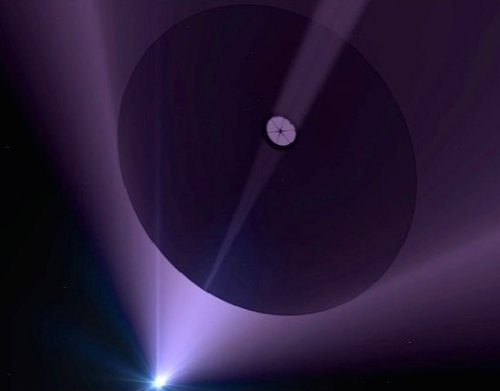
Image: Beamed propulsion leaves propellant behind, a key advantage. Coupled with very small probes, it could provide a path for flyby missions to the nearest stars. Credit: Adrian Mann.
The Visionary Era
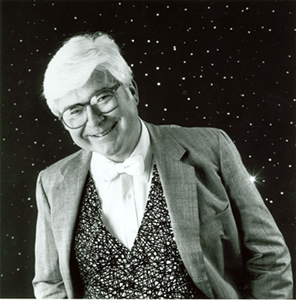
- 1962: First mention of beam-driven propulsion for interstellar purposes in the refereed literature, by Robert L. Forward, in “Pluto – Gateway to the Stars,” in Missiles and Rockets.
- 1966: G. Marx publishes the concept for Interstellar Vehicle Propelled by Laser Beam’ in Nature. He considered only x-rays to drive the sail, because he flinched from large apertures for the antenna and sail.
- 1967: Robert Forward and Eugene Mallove publish the first Interstellar Bibliography.
Image: Interstellar propulsion theorist Robert Forward.
- 1974: Authors Larry Niven and Jerry Pournelle feature an interstellar laser-pushed lightsail in their science fiction novel The Mote in God’s Eye, basing their design on unpublished calculations by Robert Forward.
- 1975: Richard Dickinson and Robert Brown demonstrate efficient transmission of 34 kW over 1.5 km.
- 1976: Robert Forward proposes a roadmap for interstellar exploration with a launch to Alpha Centauri in 1995.
- 1980: Bruce Murray, director of JPL, convenes a workshop to make a concept for an interstellar probe. Members include Freeman Dyson, Robert Forward, Robert Bussard, William Fowler and Robert Leighton. Dyson and Forward quantify Forward’s 1962 concept, including a means of returning a payload. Murray is disappointed by the large size of the sail and beamer, as well as the enormous power required. The Workshop papers are never published. Forward continues work on his concept.
- 1982: Robert Forward proposes laser-driven return star missions in his science fiction novel Flight of the Dragonfly. The final expanded version, Rocheworld, with technical appendix, appears in 1990.
- 1984: Forward presents “Roundtrip Interstellar Travel Using Laser-Pushed Sails,” the first detailed analysis showing the feasibility of the lightsail concept.
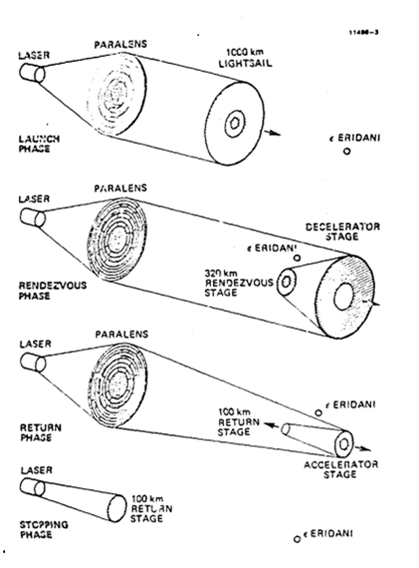
Image: Forward’s separable sail concept used for deceleration, from his paper “Roundtrip Interstellar Travel Using Laser-Pushed Lightsails,” Journal of Spacecraft and Rockets 21 (1984), pp. 187-195. The ‘paralens’ in the image is a huge Fresnel lens made of concentric rings of lightweight, transparent material, with free space between the rings and spars to hold the vast structure together, all of this located between the orbits of Saturn and Uranus.
- 1985: Forward, encouraged by conversation with Freeman Dyson, proposes microwave beam-driven interstellar flybys in “Starwisp: An Ultra-Light Interstellar Probe.” He also introduces the ‘smart sail’ concept whereby the sail contains microcircuits which capture images and diagnostic data, returns data to Earth.
- 1986: Forward conducts first study of dielectric film sails.
- 1989: Geoffrey Landis analyzes the laser driven lightsail, concluding that the performance is driven by the temperature limits of the sail, and proposes refractory dielectric films as sail material.
First Steps
- 1999: NASA Advanced Concepts Office, largely driven by JPL, proposes a roadmap for interstellar exploration with a launch to Alpha Centauri in 2028. Limited funding of initial studies and experiments follow.
Image: Plan for the development of sails for interstellar flight, 1999.
- 1999: Tim Knowles of ELSI invents the carbon micro-truss, a strong, very low areal mass density graphite sheet that doesn’t melt; it sublimes at very high temperature.
- 1999: Geoffrey Landis and James Benford propose using the new carbon micro-truss, strong structures of very low mass per square meter. They show that, with this material, a laboratory experiment can demonstrate microwave beam-powered sailing.
- December 20, 1999: Leik Myrabo-led team measures deflection of a pendulum moved by laser beam hitting sails of carbon micro-truss, giving acceleration of 0.15 gravities.
- Feb 2000: Geoff Landis reexamines use of dielectric films for highly reflective sails, points out drawbacks to multiple layers.
- March 2000: Gurkirpal Singh of JPL, in a dynamics simulation, shows that conical sails can ride a beam stably.
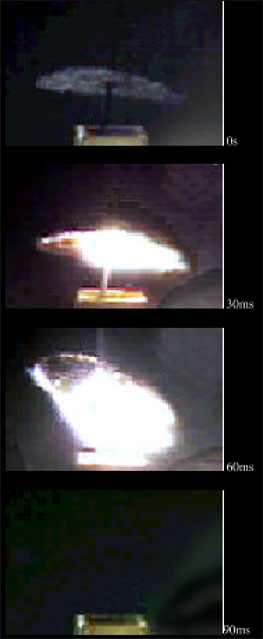
- April 5, 2000: James Benford-led team achieves first flight, at JPL. Sails of carbon micro-truss, driven by microwave beam, are accelerated up to 13 gravities; sails are recovered intact. They discover the highest accelerations are due to desorption of deeply embedded chemicals when the sail reaches high temperatures. Experiments are described in “Microwave Beam-Driven Sail Flight Experiments.”
- June 12, 2000: James Benford-led team spins a suspended micro-truss sail with circularly polarized microwave beam. Basic physics of spin-driven effects are demonstrated.
- December 8, 2000: Leik Myrabo team, using a carbon-dioxide laser, flies molyebdenum-coated carbon sails at 1 gravity above liftoff, giving velocities up to 3 m/sec.
Image: First flight of beam-driven sail. Carbon sail lifts off truncated rectangular waveguide under 10 kW microwave power. (4 frames, 30 ms interval, 1st at top).
- July 2000: Geoff Landis, in “Starwisp Revisited,” substantially reduces mass and power required for microwave-driven mesh sail.
- 2002: Stable beam-riding of a conical sail on a microwave beam demonstrated experimentally by the Benford brothers, Gregory and James, at UC Irvine. Physics of spin-driven effects on various sail shapes are explored in both experiment and theory.
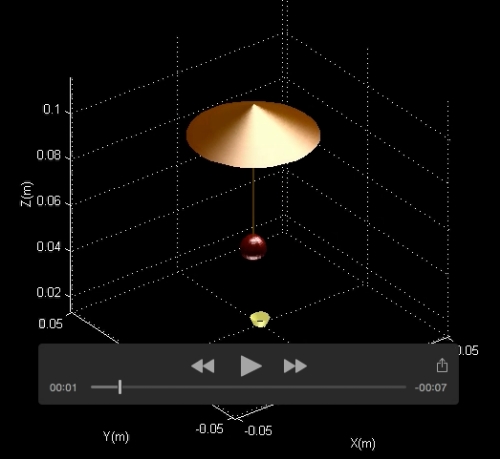
Image: Geometry of 3-D sail simulation used to access sail stability. Beam is injected from horn at bottom.
- 2003: Chaouki Abdallah and team at UNM, with a 3D dynamics simulation, confirm that the conical (umbrella) sail is the most passively stable shape, while other shapes, such as inverse conical, are not stable. They quantify the stable parameter range for beam shape, angle of the cone and location and mass ratio if sail and payload. They show that active dynamic feedback control can stabilize most shapes.

Image: Graphic user interface for sail stability simulation, Chaouki Abdallah 2003. Geometry
of sail shown above, power distribution of beam shown below.
Becoming Real
- May 21, 2010: First deployment of a functional solar sail in space, “IKAROS” (Interplanetary Kite-craft Accelerated by Radiation Of the Sun) is demonstrated by the Japanese Space Agency JAXA.
- 2011: “100 Year Starship”, a joint project between NASA (Pete Worden) and DARPA (David Neyland), convenes a colloquium in Orlando to discuss interstellar travel, stimulating interest in practical starflight.
- 2012: Greg Matloff proposes graphene for sail material that can sustain high accelerations.
- 2013: Starship Century Symposium held at UC San Diego May 20, date of the publication of the book Starship Century. A second Starship Century Symposium is held at the Royal Astronomical Society in London. In the book James Benford predicts “the first starship will be a sail – a sailship – driven by a beam of photons.”
- 2013: James Benford creates a cost-optimization equation for beam-driven propulsion systems.
- April 2015: Philip Lubin introduces concept for small ultra-light ‘spacecraft on a wafer’ using multi-layer dielectric on metalized plastic film. In “A Roadmap to Interstellar Flight,” Lubin draws on Forward’s laser-sail work and extends it into much smaller sail designs.
- August 2013: 1st Interstellar Congress held in Dallas, Texas by Icarus Interstellar. Eric Malroy introduces concepts for the use of nanomaterials in sails.
- March 2016: Yuri Milner concludes the only credible way to achieve interstellar travel in the near-term is beam-driven sails, in consultation with Avi Loeb, Pete Worden and Pete Klupar.
- April 12, 2016: Yuri Milner, Stephen Hawking and Pete Worden announce the beginning of Breakthrough Starshot, a project to launch beam-driven sails to Alpha Centauri within 20 years. Freeman Dyson is present.
- 2016: Kevin Parkin creates an engineering inference engine for optimizing beamed sail systems, including cost minimization.
- April 15, 2016: Breakthrough: Discuss, a 2 day symposium, brings together the Breakthrough Starshot team, as well as that of Breakthrough: Listen, a SETI project begun it 2015.
The notional timeline for Starshot is said to be 10 years of R&D, 10 years for construction of the System, 21 years transit time for the first sailcraft. At 0.2 c, it would enter the Alpha Centauri double-star system in 2057, a century after the first Earth satellite.
“Make no mistake — interstellar travel will always be difficult and expensive, but it can no longer be considered impossible.”
-Robert Forward, 1985
We owe it to the future to record our past. What I have described is journalism, but journalism is only the first draft of history. Doubtless there are significant events I have forgotten or never knew. Please suggest additions and modifications. A revised timeline will appear later, including references.
I thank those who I interviewed over the years about history: Robert Forward, Freeman Dyson, Geoff Landis, Kevin Parkin, Gregory Benford, Leik Myrabo, Pete Klupar, Avi Loeb and Gregory Matloff.

Revisiting Enceladus’ Ocean
As we saw yesterday, there is a case to be made that the ocean beneath Pluto’s ice is still liquid, based on phase changes in ice under varying pressures and temperatures. Today we turn to another world with interesting oceanic possibilities, Enceladus. Here the data are problematic and contradictory. Flybys by the Cassini Saturn orbiter detected tiny deviations in the spacecraft’s trajectory that could be used to measure the gravity of the Saturnian moon.
Weighing these perturbations in the spacecraft’s motion against the known topography of Enceladus, scientists could draw tentative conclusions about the moon’s internal structure. Enceladus appeared to be internally asymmetric, with an ice shell between 30 and 40 kilometers thick in the southern hemisphere, perhaps thickening to 60 kilometers at the equator. Moreover, the Cassini data were not sufficient to conclude anything about the extent of the ocean. Did it extend beneath the entire shell, or was it confined largely to the southern polar regions?
Work out of Cornell University in 2015 charted some 5800 surface features at different angles and times, bringing dynamical modeling and statistical analysis to bear on Enceladus’ interior. Peter Thomas and team found that they could use a wobble in the moon’s rotation — a libration — to show that the surface of Enceladus was not solidly connected with its core. The libration, then, told us that the ocean was global. It also pointed to thinner ice, with a mean thickness of about 20 kilometers, a result inconsistent with the Cassini gravity studies.
To resolve the contradiction, a new model from a team of international researchers now proposes an asymmetric model with a strong heat source. The work sees a rocky core with radius of 185 kilometers, an internal ocean about 45 kilometers deep, and an ice shell with a mean thickness of around 20 kilometers except at the south pole, where it appears to be less than 5 kilometers thick. The ocean in this model comprises about 40 percent of the total volume of Enceladus, and the salt content is estimated to be similar to that of Earth’s oceans.

Image: The thickness of Enceladus’s ice shell, which reaches 35 kilometers in the cratered equatorial regions (shown in yellow) and less than 5 kilometers in the active south polar region (shown in blue). Credit: LPG-CNRS-U. Nantes/U. Charles, Prague.
Relatively thin ice in the south polar regions is promising for future exploration. But while this model gives us a way to reconcile previous results, it also offers another question. A thinner ice shell holds less heat, which means tidal stresses caused by Saturn can no longer explain the heat flow affecting the south polar region. We must be dealing with strong heat production deep inside Enceladus that may be driving hydrothermal venting on the ocean floor.
And yes, complex organic molecules have been found in the plumes from Enceladus, making for an astrobiologically interesting scenario when coupled with a warm ocean. But we’ll need a closer look to find out whether the model put forth by Ond?ej ?adek (Charles University, Prague) and his colleagues at the Royal Observatory of Belgium and the Laboratoire de Planétologie Géodynamique de Nantes holds up. Thin ice at the south pole could offer us a window into the ocean, a study relevant not just to Enceladus but many icy objects in the outer system.
The paper is ?adek et al, “Enceladus’s internal ocean and ice shell constrained from Cassini gravity, shape, and libration data,” published online by Geophysical Research Letters 11 June 2016 (abstract).

Pluto: Evidence for a Liquid Internal Ocean
What accounts for Pluto’s interesting landscape? As we accumulate more and more data from New Horizons, we’re seeing a wide range of geologic activity on the surface, most of it involving such volatile ices as nitrogen, carbon dioxide and methane. But look at the troughs and scarps — some of them hundreds of kilometers long and several kilometers deep — and you’re seeing what are thought to be extensional faults. These are faults associated with the stretching of the dwarf planet’s crust, and in the New Horizons imagery, they appear geologically young.
We could look toward tidal interactions with Charon for an answer to what is driving tectonic activity on Pluto, but the Pluto/Charon system has reached what a new paper on the matter calls “the end point of its tidal evolution,” with the two objects locked into a synchronous state that makes the prospect unlikely. But changes in the ice shell are another matter, and as Noah Hammond (Brown University) and his fellow researchers are learning, the sinuous faults on Pluto’s surface provide evidence for a subsurface ocean that remains liquid today, though one that is probably in the process of re-freezing.

Image: The New Horizons spacecraft spied extensional faults on Pluto, a sign that the dwarf planet has undergone a global expansion possibly due to the slow freezing of a subsurface ocean. A new analysis by Brown University scientists bolsters that idea, and suggests that ocean is likely still there today. NASA/JHUAPL/SwRI.
What Hammond, a Brown graduate student, produced with colleagues Edgar Parmentier (also at Brown) and Amy Barr (Planetary Science Institute) was a model of thermal evolution that could be fed New Horizons’ data on Pluto’s diameter and density to study its interior. The energy to melt Pluto’s internal ice could have come from radioactive elements within its core, producing an ocean that would, in the frigid conditions of the Kuiper Belt, gradually begin to refreeze. An ocean that was frozen or in the process of freezing would produce the kind of extensional tectonics we see on Pluto today, assuming it were made up of normal water ice.
But different forms of ice are the crux of the argument. For low temperatures and high pressure deep within Pluto would, in a solidly frozen ocean, produce not normal ice (Ice Ih, or ice phase one) but a rhombohedral crystalline form of ice with a highly ordered structure called Ice II. The compact structure of Ice II creates a frozen ocean of smaller volume — Ice II is 25 percent more dense than normal ice — and results in contraction rather than expansion.
We have a good deal of New Horizons imagery, but find no evidence on Pluto’s surface of such global contraction — no compressional tectonic features — leading Hammond’s team to conclude that Ice II has not formed, and that the ocean is therefore not completely frozen.
Critical to the argument is the thickness of the dwarf planet’s ice shell, because Ice II should form only if the shell is 260 kilometers thick or more. Anything less produces an ocean that can freeze without forming Ice II, and hence a frozen ocean that does not cause contraction. But the authors’ thermal model, adjusting the physical properties of both the silicate core and the ice shell, produces a shell that is closer to 300 kilometers thick. Moreover:
…the influence of volatile ices such as nitrogen and methane may be more effective at insulating the ocean than shown in our model. We assume volatiles are concentrated in the top 10 km of Pluto’s ice shell, but if methane clathrates are abundant in the entire ice shell, its thermal conductivity may be significantly reduced…, increasing the likelihood that the ocean will survive. We find that if the ice shell has a constant thermal conductivity of 3 W/m/K, a subsurface ocean survives even if the thermal conductivity of the core is high. The likelihood of ocean survival further increases when considering that as the ocean begins to freeze, impurities are excluded from the ice shell and ammonia and salt concentrations in the ocean will increase, further reducing the melting temperature.
A still liquid ocean gradually re-freezing within Pluto would generate continuing global expansion, producing extensional tectonic activity and young surface features. What we do not see are the kind of compressional tectonic features that would indicate the formation of Ice II. The paper’s conclusion, then, is that there are two possibilities: Either Pluto has an ocean today or it has an ice shell thinner than 260 kilometers. The latter could imply a frozen ocean (Ice Ih), but we still have to account for Pluto’s geologically young faults. A search of New Horizons data for evidence of current extensional tectonics is perhaps the best way to proceed.
Phase changes in ice can, according to this work, produce tectonic changes on the surface even for objects at the edge of the Solar System where energy is sparse. If this kind of tectonic activity can occur on Pluto, it should be possible on other Kuiper Belt objects, suggestive of continuing activity and perhaps a huge inventory of water in icy moons and KBOs.
The paper is Hammond, Barr and Parmentier, “Recent Tectonic Activity on Pluto Driven by Phase Changes in the Ice Shell,” in press at Geophysical Research Letters (abstract / preprint).





